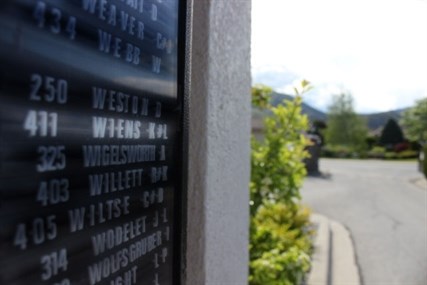
The gated community where Kalmring was killed still shows Wiens name on the outer gate.
(SHANNON QUESNEL / iNFOnews.ca)
July 15, 2013 - 2:05 PM
KELOWNA - Blood stains found on the body of Lynn Kalmring following a fatal 2011 shooting appears to be key evidence in the trial for Keith Gregory Wiens.
Wiens is charged with second degree murder and today the defence called its own expert blood pattern analyst to the stand. Private consultant Joseph Slemko, one of Canada's few certified senior crime scene analysts who's attended 800 crime scenes in his 20 years of policing, gave his own interpretation of the crime scene today.
Just a week ago blood stain analyst RCMP Sgt. Diane Cockle told the jury the victim's body was marked by stains from an incident prior to the shooting. She pointed to a number of stains inside the victim's nightgown and upper thighs - not caused by the gunshot.
Crown lawyer Colin Forsyth then suggested Wiens might have struck Kalmring in the face prior to shooting her, causing her to bleed.
Slemko was shown the same photos Cockle used in her analysis. He told the jury the photos alone don't substantiate the theory of a prior bloodletting.
He noted the gunshot wound was the only possible source of blood, which would cause spatter and arterial spurts. The alternate pattern of stains could have come from blood contaminating the victim's airway when expired or coughed out, or deposited from spasms in the body.
While he agreed there are two events in which blood was deposited - it's impossible to determine when they happened.
“It depends on timing... it could be milliseconds or it could be hours,” he said. To suggest one stain occurred prior to the gunshot is “a huge leap."
“That's a very dangerous opinion to give... there's too many factors involved.”
Relying strictly on photos taken at the crime scene and autopsy table isn't enough to reconstruct the events that took place. When transferring a body to the autopsy table, “there can be all sorts of contamination taking place,” he says.
Referring to one photo from the crime scene he said, “I wouldn't even be comfortable saying that's blood,” due to poor lighting and lack of colour differentiation.
“Ideally I would like to be at the scene” using a flashlight, he says.
Slemko says he's previously tesified “on both sides of the law” and offers independent consulting on crime scene analysis. He's worked on many cases involving wrongful convictions caused by biased RCMP investigation.
He continues to testify this afternoon.
To contact the reporter for this story, email Julie Whittet at jwhittet@infotelnews.ca or call (250)718-0428.
News from © iNFOnews, 2013